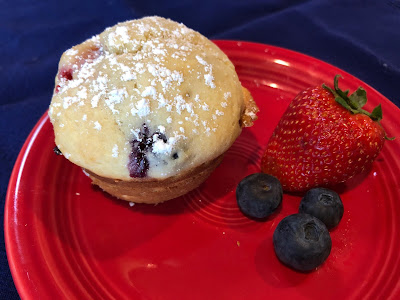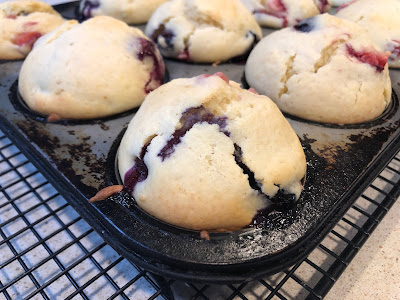
Recipe: Ricotta muffins feature strawberries and blueberries
 |
| This muffin is a great use for fresh summer fruit. (Photos: Kathy Morrison) |
Fresh local fruit is so wonderful in baked goods. I'm always looking for new ways to feature it, especially in quick recipes that don't require much time in the kitchen on warming-to-hot day. That's why I like baking for breakfast or weekend brunch: I'm done long before the temps are unbearable.
This recipe, adapted from "Bake From Scratch: Volume 3," by Brian Hart Hoffman, gives a fruit muffin an intriguing tang by including ricotta cheese. I've used strawberries and blueberries here because that's what I had on hand, but I could see it working just as well with blackberries, cherries or the peaches that are just coming to market.
Note: This makes a lot of batter. I chose to bake 12 extra-large muffins in a regular muffin pan, but you could use two pans to make about 16 regular-size muffins, or put the extra in a mini-muffin pan for snack-size muffins.
Ricotta muffins with fruit
Makes 16 regular or 12 extra-large muffins
Ingredients:
2-1/4 cups unbleached all-purpose flour
3/4 cup granulated sugar
2 teaspoons baking powder
1/2 teaspoon salt
1 cup ricotta cheese (whole-milk or low-fat)
2 large eggs
2/3 cup whole milk
1/4 cup canola or other neutral vegetable oil
2 teaspoons vanilla extract
3/4 cup diced fresh strawberries
3/4 cup fresh blueberries, checked for stems, washed and gently dried
Confectioners' sugar, for finishing
Instructions :
Preheat oven to 350 degrees. Prepare the muffin pan(s), either by spraying with cooking spray or lining with paper liners.
Combine in a large bowl the flour, sugar, baking powder and salt. Set aside.
 |
| These muffins are done, even though they're hardly brown at all. |
In a medium bowl or large glass measuring cup, stir together the ricotta and eggs, then add the milk. Stir in the oil and the vanilla extract.
Add the ricotta mixture to the flour mixture, stirring with a wooden spoon or flexible spatula until just combined. Gently fold in the prepared fruit.
Divide the batter among the prepared cups. Bake until a wooden pick inserted in the center comes out clean, about 20 minutes for regular-size muffins or 25 minutes for larger ones.
Note: The muffins do not brown much, if at all, so don't use their color as an indication of doneness.
Remove muffins from oven and allow to cool 10 minutes. Garnish with confectioners' sugar before serving. Store any leftover muffins covered, in the refrigerator. (They reheat well in the microwave.)
Variations:
Substitute 1-1/4 to 1-1/2 cups peeled diced peaches (pat fruit pieces with a paper towel if the peaches are very ripe) or pitted chopped cherries in place of the berries, and use a combination of 1 teaspoon almond extract and 1 teaspoon vanilla extract.
For blackberry muffins, use 1-1/4 cups washed fresh berries and 2 teaspoons vanilla extract. Stir in 1/2 teaspoon lemon or lime zest if desired.
Comments
0 comments have been posted.Sacramento Digs Gardening to your inbox.
Sites We Like
Garden Checklist for week of April 14
It's still not warm enough to transplant tomatoes directly in the ground, but we’re getting there.
* April is the last chance to plant citrus trees such as dwarf orange, lemon and kumquat. These trees also look good in landscaping and provide fresh fruit in winter.
* Smell orange blossoms? Feed citrus trees with a low dose of balanced fertilizer (such as 10-10-10) during bloom to help set fruit. Keep an eye out for ants.
* Apply slow-release fertilizer to the lawn.
* Thoroughly clean debris from the bottom of outdoor ponds or fountains.
* Spring brings a flush of rapid growth, and that means your garden needs nutrients. Fertilize shrubs and trees with a slow-release fertilizer. Or mulch with a 1-inch layer of compost.
* Azaleas and camellias looking a little yellow? If leaves are turning yellow between the veins, give them a boost with chelated iron.
* Trim dead flowers but not leaves from spring-flowering bulbs such as daffodils and tulips. Those leaves gather energy to create next year's flowers. Also, give the bulbs a fertilizer boost after bloom.
* Pinch chrysanthemums back to 12 inches for fall flowers. Cut old stems to the ground.
* Mulch around plants to conserve moisture and control weeds.
* From seed, plant beans, beets, cantaloupes, carrots, corn, cucumbers, melons, radishes and squash.
* Plant onion sets.
* In the flower garden, plant seeds for asters, cosmos, celosia, marigolds, salvia, sunflowers and zinnias.
* Transplant petunias, zinnias, geraniums and other summer bloomers.
* Plant perennials and dahlia tubers for summer bloom.
* Mid to late April is about the last chance to plant summer bulbs, such as gladiolus and tuberous begonias.
* Transplant lettuce seedlings. Choose varieties that mature quickly such as loose leaf.